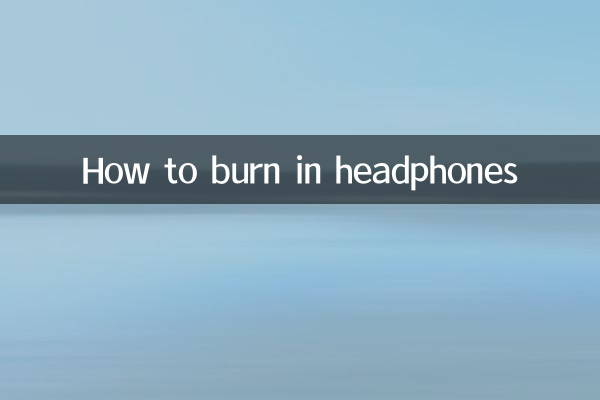How to turn on headphones: scientific method and analysis of hot topics
In recent years, with the popularity of audio equipment, headphone burn-in has become a hot topic among audiophiles and ordinary users. Burn-in refers to the process of playing sounds of a specific frequency for a long time to bring the diaphragm, coil and other components of the earphones into optimal working condition. This article will combine hot topics in the past 10 days to provide you with a detailed analysis of the scientific method of turning on headphones and provide structured data for reference.
1. Why do you need to burn in the machine?

The core purpose of the burn-in is to allow the internal mechanical components of the earphones (such as diaphragms, magnets, etc.) to naturally break in to achieve more stable acoustic performance. Supporters believe that the sound quality of headphones after a burn-in period is softer, the high frequencies are smoother, and the low frequencies are more elastic; while opponents believe that modern headphone technology is mature enough and the burn-in effect is minimal.
2. Analysis of hot topics in the past 10 days
The following are the hot topics of discussion on the entire network in the past 10 days regarding headphone burn-in:
| topic | heat index | Main point |
|---|---|---|
| "Does the headset need to be burned in?" | 85 | It’s quite controversial, 50% of users think it’s effective, 30% think it has psychological effects, and 20% are unsure. |
| "Scientific cooking method" | 78 | Users are more concerned about how to avoid damaging their headphones |
| "Recommended software for burning in the machine" | 65 | Popular software includes: Burn-in Wave Generator, Audio Toolkit, etc. |
| "Comparison of the burn-in effects of headphones at different price points" | 72 | High-end headphones (>2000 yuan) have a more obvious burn-in effect |
3. The scientific method of burning in headphones
The following are industry-proven steps for burning in headphones:
| stage | duration | Recommended frequency | Things to note |
|---|---|---|---|
| Early stage (white noise) | 20-30 hours | 20Hz-20kHz frequency sweep | Volume control below 50% |
| Mid-term (music burn-in) | 50-70 hours | Diverse music genres | Avoid extreme volume levels |
| Later (natural use) | 100 hours+ | Listen to music normally | Pay attention to changes in sound quality |
4. Recommended burn-in time for popular headphones
Common headphone burn-in times compiled based on recent user feedback:
| Headphone type | Recommended boiling time | Significant improvements |
|---|---|---|
| Entry level (<500 yuan) | 50-80 hours | IF resolution |
| Mid-range (500-2000 yuan) | 80-120 hours | Sound field width |
| High-end (>2000 yuan) | 120-200 hours | Full frequency band equalization |
5. Things to note
1.Volume control: When the phone is turned on, the volume should not exceed 70% of the normal listening volume to avoid damaging the diaphragm.
2.intermittent rest: It is recommended to rest the headphones for 1 hour after every 4-5 hours of continuous use to prevent overheating.
3.music selection: It is recommended to use music containing rich frequencies, such as classical music, jazz, etc., to avoid single-frequency test sounds.
4.Treat rationally: The burn-in effect varies from person to person. Some high-end headphones have undergone professional aging tests before leaving the factory and may not require additional burn-in.
6. Common Misunderstandings
1."The louder the volume, the better the effect": This is a misconception. Excessive volume will permanently damage the headphones.
2.“You must use professional burn-in software”: In fact, ordinary music can also achieve similar effects. The key is diversified frequency stimulation.
3.“All headphones need to be burned in”: Due to structural characteristics of some moving iron unit headphones, the burn-in effect is not obvious.
Conclusion
Headphone burn-in is a technology that combines science and experience. Although modern headphone manufacturing processes have greatly reduced the need for a "break-in period," a proper burn-in process may still improve the listening experience. The most important thing is that while pursuing perfect sound quality, you should also enjoy the fun brought by the music itself.

check the details

check the details